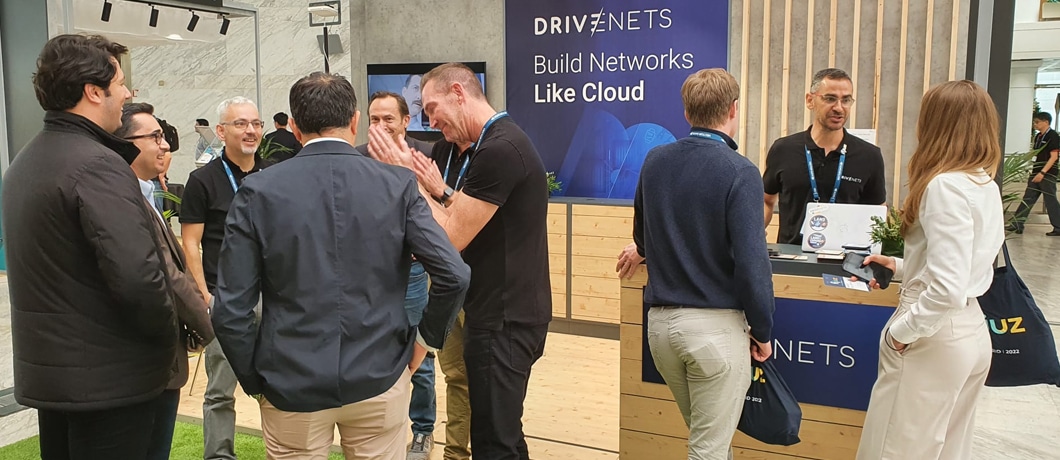Moving out of COVID-19 limitations has been, and still is, sluggish and cumbersome. It took a lot of effort to pull together TIP’s annual summit, which was designed to get people together to physically interact and socialize, just like in the old days (of 2019…). Some creative thinking behind TIP’s agenda and food gave us “Fÿuz” – an event with so much spice that you could literally taste it.
DDBR (Distributed Disaggregated Backbone Router)
DriveNets participation at TIP is mainly around the DDBR (Distributed Disaggregated Backbone Router). DDBR is an expansion to the OCP’s (Open Compute Project’s) definition of DDC (C is for chassis), which was already in deployment at AT&T’s core network when TIP took it in and expanded it with router functionality definitions.
Completing these definitions was soon to follow, and that positioned DDBR as an “off-the-shelf” solution for operators to install into their networks. This is indeed what we have seen with Turkcell. The operator is not only taking the solution but taking it publicly, letting the world know that its network evolution is tightly coupled with taking control from the hands of vendors and placing it into its own hands.
Fixed broadband and transport – from farm to table
As this was the first (well, officially) commercial deployment of DDBR, TIP hosted a panel of speakers on this topic. The panel included the two vendors involved – UfiSpace providing the hardware and DriveNets providing the software – as well as Turkcell and a moderator from TIP. The input from Turkcell was optimistic, highlighting the potential that such technology holds for the operator. What was clear is the flexibility that Turkcell has in choosing components, and the fact that each component can also be replaced without hindering the behavior of the live network. I typically wouldn’t recommend that operators swap out components of a live system; yet the very fact that this is an option forces vendors out of the comfort zone of incumbent vendors and pushes them to continuously perform at the highest level.
UfiSpace and DriveNets are not the only two available options supporting a DDBR solution. Delta and Capgemini also have been awarded TIP ribbons as vendors supporting such a solution. Other software and hardware vendors have also joined the group after being awarded ribbons, so the ecosystem is alive and growing.
Amazing time at Fÿuz
So much for what I knew was coming and expected to see at Fÿuz. For the surprising extras, I will start with the food. It was tasty and plentiful throughout the three days of the event, including different foods from around the world all “fyuzed” into one location in Madrid.
In a similar way, network components from vendors spanning the globe were brought in and “fyuzed” together to form solutions that are greater than the sum of their parts. As long as COVID-19 ruled our schedules, running such an event was practically impossible, so multiple solutions evolved almost separately. Once the gates were opened, the grouping of vendors into one place created this explosion of solution exposure in the heart of the industry.
Looking at disaggregated solutions
At this “heart” of the industry, operators have been looking at disaggregated solutions for a while. I’d even say they were waiting for such an event to take place. They arrived with a focus to find the solution they were looking for to get their networks on the right path, and not just to get an overview of what’s available. Fÿuz participants were intelligent, eager to learn, open to new ideas, and willing to think outside the box – all welcome attributes for fueling evolution.
So much for the extras I was happy to get at Fÿuz. And just like every good meal leaves you with a taste for more, here is what I expect to see as we progress. We will see some official testing by TIP for the DDBR solution. This will likely award DriveNets with a medal that indicates the maturity of our solution. With two years of run time at AT&T’s core and at several other tier-1 operators, I am rather confident on how this will play out.
Next steps: bringing disaggregation to more operators
From a regional perspective, TIP is expected to reach outside of the European and African domains and become more dominant throughout Asia and the Americas. In other words, what I would like to see next are the operators that are not looking at disaggregation just yet. My own guess is that we will see them soon enough in the TIP pavilion at MWC Barcelona.
Download White Paper
From Network on a Cloud to Network Cloud




